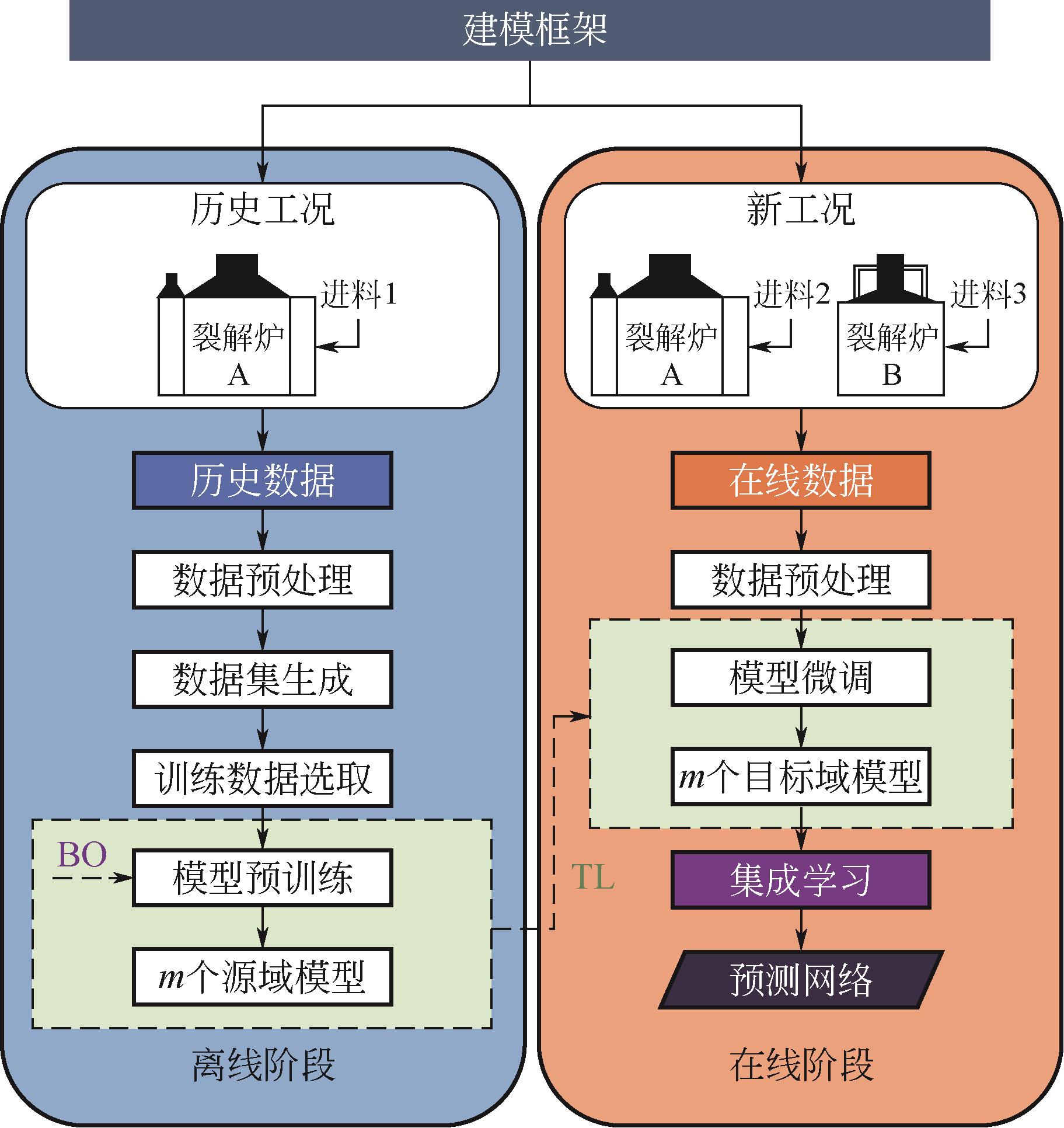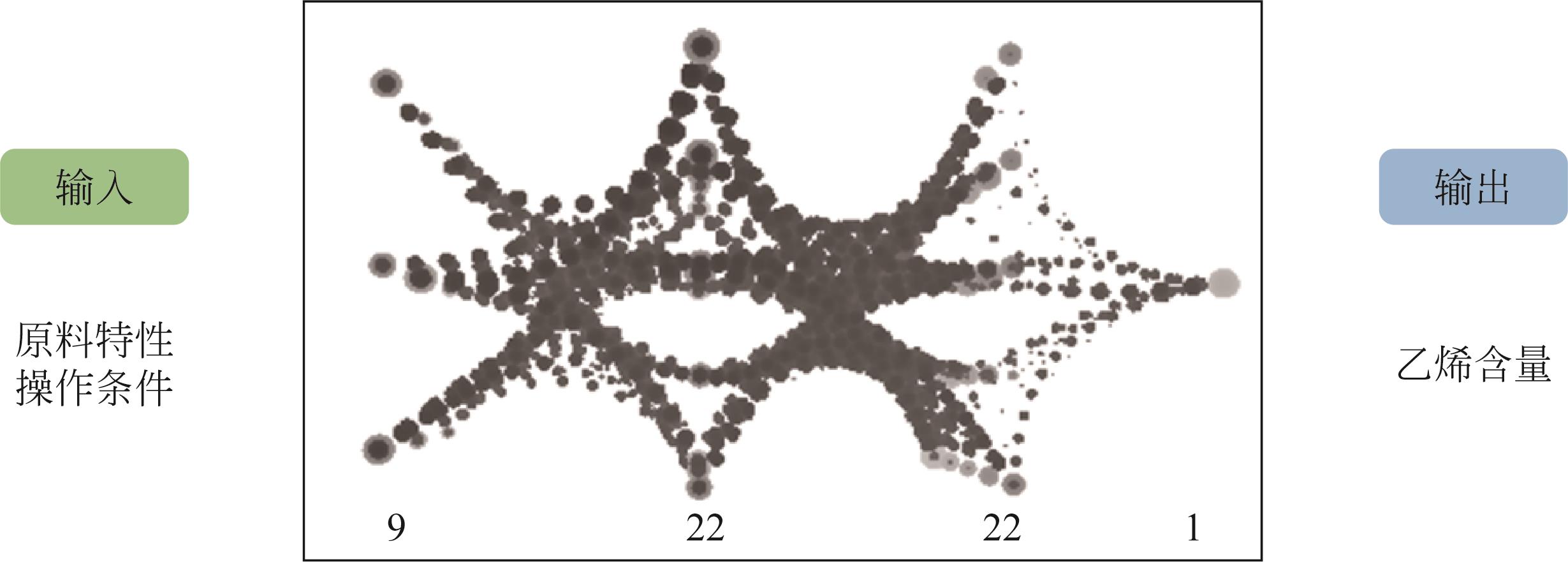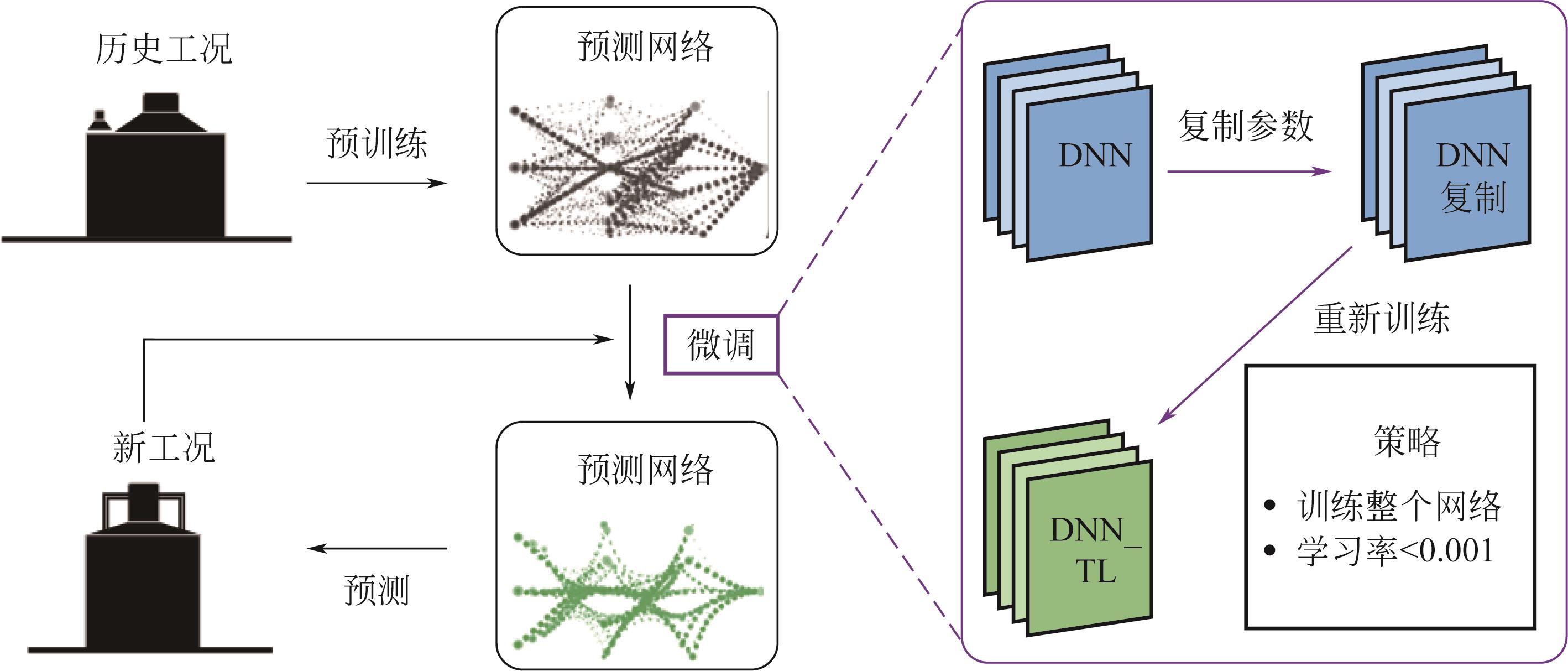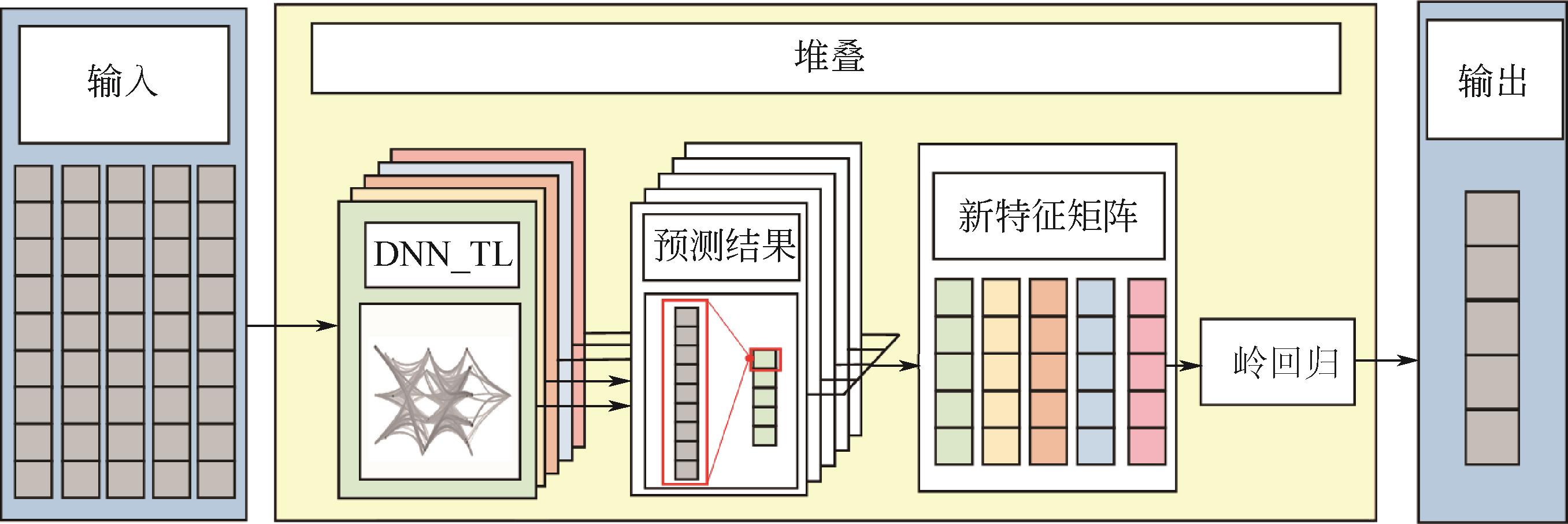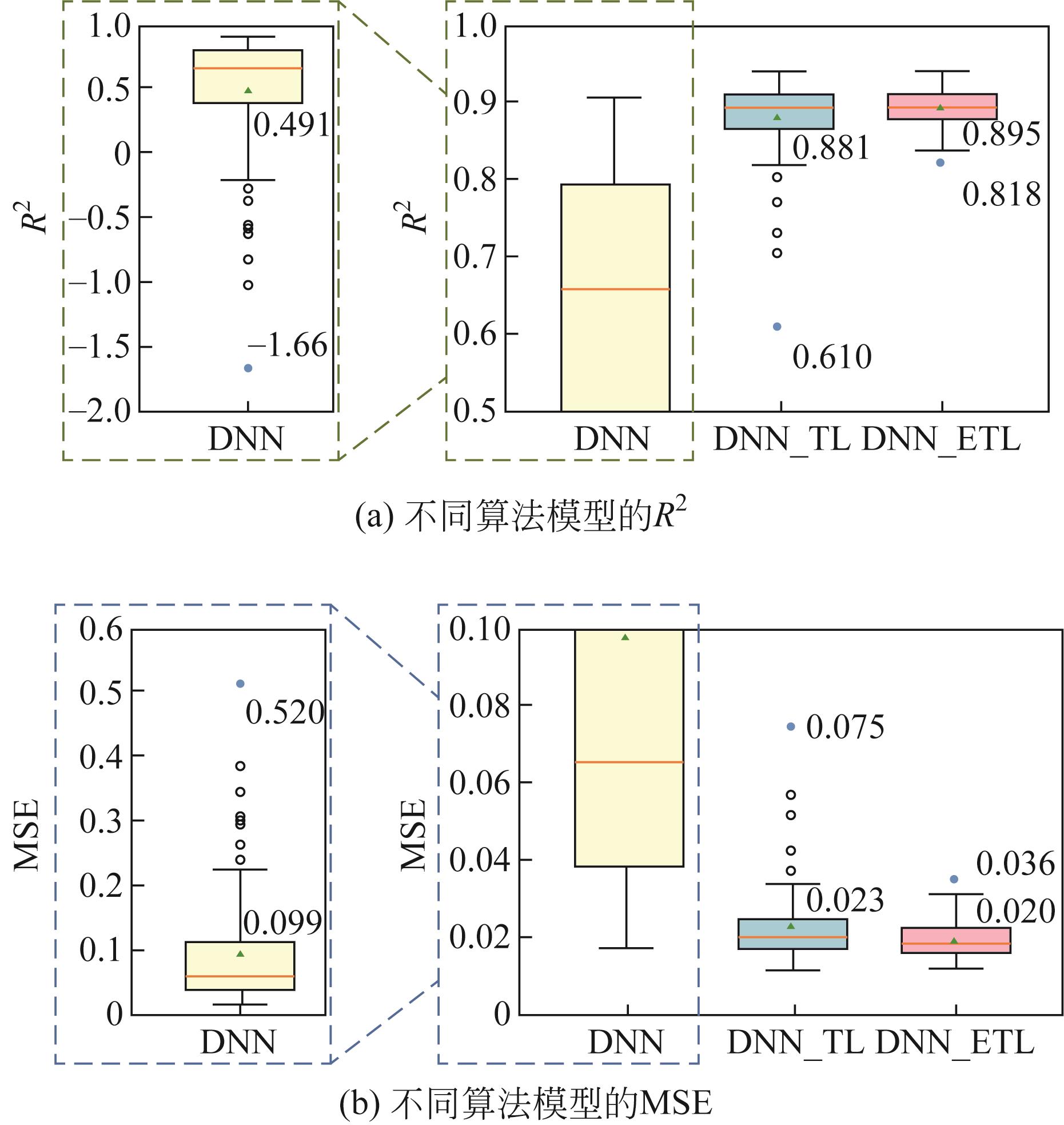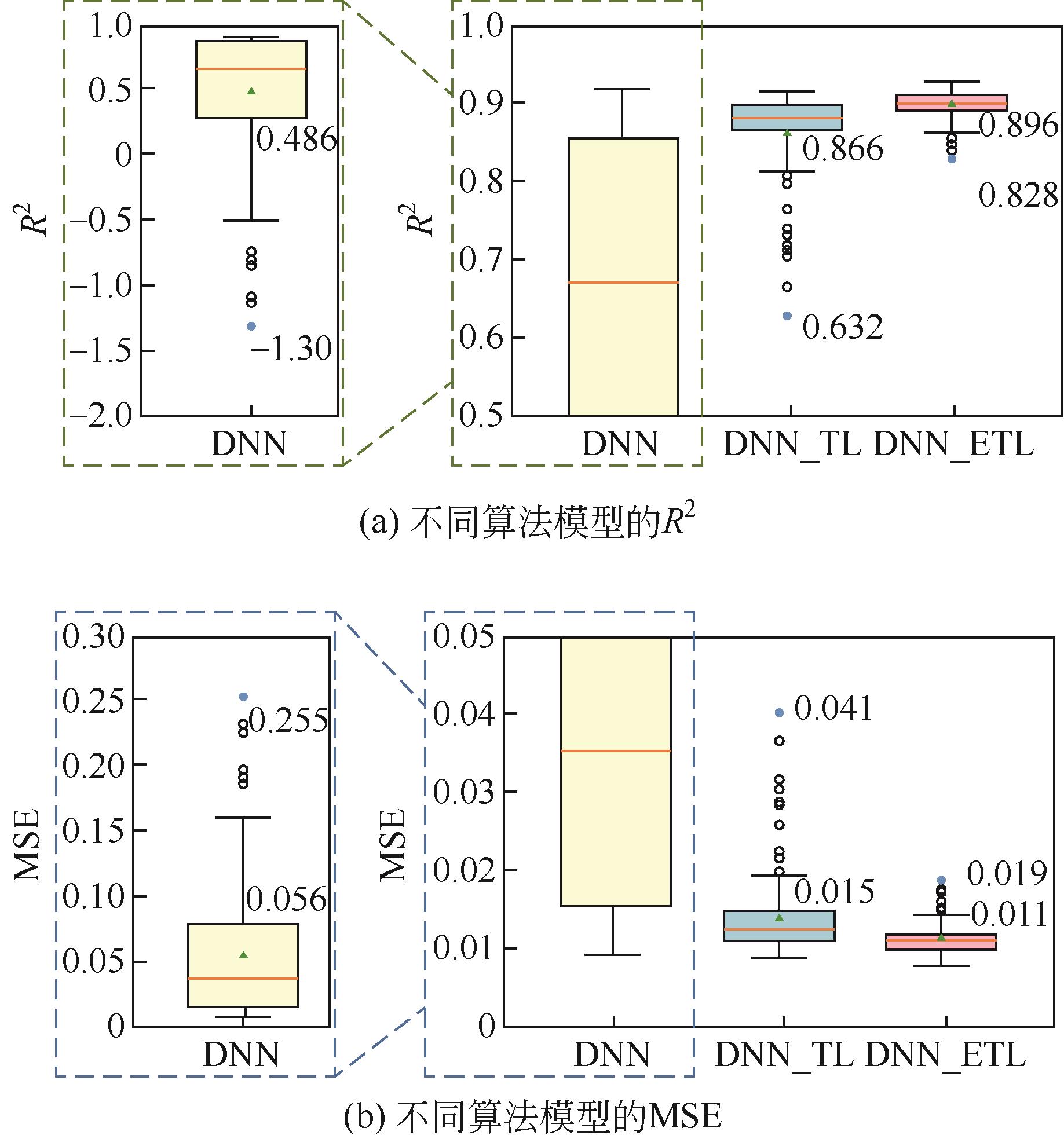化工进展 ›› 2024, Vol. 43 ›› Issue (5): 2880-2889.DOI: 10.16085/j.issn.1000-6613.2023-2210
• 集成耦合与优化 • 上一篇
用于蒸汽裂解产物成分预测的集成迁移学习框架
郑可欣1( ), 江雨欣2, 毕可鑫1(
), 江雨欣2, 毕可鑫1( ), 赵祺铭3, 陈少臣1, 王冰冰1, 任俊宇1, 吉旭1, 邱彤3, 戴一阳1
), 赵祺铭3, 陈少臣1, 王冰冰1, 任俊宇1, 吉旭1, 邱彤3, 戴一阳1
- 1.四川大学化学工程学院,四川 成都 610065
2.帝国理工化学工程学院,英国 伦敦 SW7 2AZ
3.清华大学化学工程系,北京 100084
-
收稿日期:2023-12-15修回日期:2024-01-05出版日期:2024-05-15发布日期:2024-06-15 -
通讯作者:毕可鑫 -
作者简介:郑可欣(1998—),女,硕士研究生,研究方向为过程系统工程。E-mail:zhengkexin@stu.scu.edu.cn。 -
基金资助:国家重点研发计划(2021YFB4000500)
Ensemble transfer learning framework for outflow compositions prediction in steam cracking process
ZHENG Kexin1( ), JIANG Yuxin2, BI Kexin1(
), JIANG Yuxin2, BI Kexin1( ), ZHAO Qiming3, CHEN Shaochen1, WANG Bingbing1, REN Junyu1, JI Xu1, QIU Tong3, DAI Yiyang1
), ZHAO Qiming3, CHEN Shaochen1, WANG Bingbing1, REN Junyu1, JI Xu1, QIU Tong3, DAI Yiyang1
- 1.School of Chemical Engineering, Sichuan University, Chengdu 610065, Sichuan, China
2.Department of Chemical Engineering, Imperial College London, London SW7 2AZ, UK
3.Department of Chemical Engineering, Tsinghua University, Beijing 100084, China
-
Received:2023-12-15Revised:2024-01-05Online:2024-05-15Published:2024-06-15 -
Contact:BI Kexin
摘要:
回顾了蒸汽裂解过程建模的方法,阐述了工业实际情况中面临的数据匮乏问题。面对石油化工行业大量的小数据集建模需求,充分利用历史生产数据,提出了一种集成迁移学习框架。首先,利用充足的数据在特定工况下建立了基本的深度学习模型。然后,利用小数据集将迁移学习技术应用于新的工况,源域的专家知识通过基于参数的方法转移到目标领域。最后,引入集成学习来整合获得的迁移学习模型,从而提高性能。在几个实际案例上进行实践,研究了该模型框架的性能。为了更好地理解模型,还进一步实施了层可迁移性分析和SHapley Additive exPlanation(SHAP)特征重要性分析。结果说明该方法训练出的模型具有良好的准确性、稳定性、计算效率和可解释性,可以满足工业需求。
中图分类号:
引用本文
郑可欣, 江雨欣, 毕可鑫, 赵祺铭, 陈少臣, 王冰冰, 任俊宇, 吉旭, 邱彤, 戴一阳. 用于蒸汽裂解产物成分预测的集成迁移学习框架[J]. 化工进展, 2024, 43(5): 2880-2889.
ZHENG Kexin, JIANG Yuxin, BI Kexin, ZHAO Qiming, CHEN Shaochen, WANG Bingbing, REN Junyu, JI Xu, QIU Tong, DAI Yiyang. Ensemble transfer learning framework for outflow compositions prediction in steam cracking process[J]. Chemical Industry and Engineering Progress, 2024, 43(5): 2880-2889.
| 评估参数 | 模型1 | 模型2 | 模型3 | 模型4 | 模型5 |
|---|---|---|---|---|---|
| R2 | 0.861 | 0.927 | 0.972 | 0.837 | 0.872 |
| MSE | 0.008 | 0.006 | 0.013 | 0.013 | 0.009 |
表1 源域模型的准确性
| 评估参数 | 模型1 | 模型2 | 模型3 | 模型4 | 模型5 |
|---|---|---|---|---|---|
| R2 | 0.861 | 0.927 | 0.972 | 0.837 | 0.872 |
| MSE | 0.008 | 0.006 | 0.013 | 0.013 | 0.009 |
| 评估参数 | DNN | DNN_TL | DNN_ETL |
|---|---|---|---|
| R2 | 0.491 | 0.881 | 0.895 |
| R2_std | 0.463 | 0.046 | 0.025 |
| R2_min | -1.66 | 0.610 | 0.818 |
| MSE | 0.099 | 0.023 | 0.020 |
| MSE_std | 0.090 | 0.009 | 0.005 |
| MSE_max | 0.520 | 0.075 | 0.036 |
表2 案例1的DNN模型、DNN_TL模型和DNN_ETL模型的平均性能
| 评估参数 | DNN | DNN_TL | DNN_ETL |
|---|---|---|---|
| R2 | 0.491 | 0.881 | 0.895 |
| R2_std | 0.463 | 0.046 | 0.025 |
| R2_min | -1.66 | 0.610 | 0.818 |
| MSE | 0.099 | 0.023 | 0.020 |
| MSE_std | 0.090 | 0.009 | 0.005 |
| MSE_max | 0.520 | 0.075 | 0.036 |
| 评估参数 | DNN | DNN_TL | DNN_ETL |
|---|---|---|---|
| R2 | 0.486 | 0.866 | 0.896 |
| R2_std | 0.494 | 0.054 | 0.019 |
| R2_min | -1.30 | 0.632 | 0.828 |
| MSE | 0.056 | 0.015 | 0.011 |
| MSE_std | 0.055 | 0.006 | 0.002 |
| MSE_max | 0.255 | 0.041 | 0.019 |
表3 案例2的100次实验中DNN、DNN_TL和DNN_ETL 模型的平均性能
| 评估参数 | DNN | DNN_TL | DNN_ETL |
|---|---|---|---|
| R2 | 0.486 | 0.866 | 0.896 |
| R2_std | 0.494 | 0.054 | 0.019 |
| R2_min | -1.30 | 0.632 | 0.828 |
| MSE | 0.056 | 0.015 | 0.011 |
| MSE_std | 0.055 | 0.006 | 0.002 |
| MSE_max | 0.255 | 0.041 | 0.019 |
| 配置 | DNN预训练 | 案例1中的集成迁移 | 案例2中的集成迁移 | ||||||
|---|---|---|---|---|---|---|---|---|---|
| CPU | GPU | 训练时间 | 训练时间 | 运算时间 | 训练时间 | 运算时间 | |||
| i7-12700KF 3.60 GHz | RTX 3060 (19.9GB) | 约23min | 约1.1min | 5.8μs | 约2.1min | 5.5μs | |||
表4 集成迁移学习算法不同阶段的计算效率
| 配置 | DNN预训练 | 案例1中的集成迁移 | 案例2中的集成迁移 | ||||||
|---|---|---|---|---|---|---|---|---|---|
| CPU | GPU | 训练时间 | 训练时间 | 运算时间 | 训练时间 | 运算时间 | |||
| i7-12700KF 3.60 GHz | RTX 3060 (19.9GB) | 约23min | 约1.1min | 5.8μs | 约2.1min | 5.5μs | |||
| 序号 | 第一层 | 第二层 | 第三层 | 案例 1 | 案例 2 |
|---|---|---|---|---|---|
| 1 | × | 0.832 | 0.783 | ||
| 2 | × | 0.876 | 0.858 | ||
| 3 | × | 0.881 | 0.866 | ||
| 4 | × | × | 0.720 | 0.676 | |
| 5 | × | × | 0.876 | 0.858 | |
| 6 | × | × | 0.835 | 0.783 | |
| 7 | 0.881 | 0.866 |
表5 7种冻结方案平均R2对比
| 序号 | 第一层 | 第二层 | 第三层 | 案例 1 | 案例 2 |
|---|---|---|---|---|---|
| 1 | × | 0.832 | 0.783 | ||
| 2 | × | 0.876 | 0.858 | ||
| 3 | × | 0.881 | 0.866 | ||
| 4 | × | × | 0.720 | 0.676 | |
| 5 | × | × | 0.876 | 0.858 | |
| 6 | × | × | 0.835 | 0.783 | |
| 7 | 0.881 | 0.866 |
| 1 | Tomáš HÁK, Svatava JANOUŠKOVÁ, MOLDAN Bedřich. Sustainable development goals: A need for relevant indicators[J]. Ecological Indicators, 2016, 60: 565-573. |
| 2 | HUANG Mengtian, ZHAI Panmao. Achieving Paris Agreement temperature goals requires carbon neutrality by middle century with far-reaching transitions in the whole society[J]. Advances in Climate Change Research, 2021, 12(2): 281-286. |
| 3 | LIN Xinwei, ZHAO Liang, DU Wenli, et al. Data-driven modeling and cyclic scheduling for ethylene cracking furnace system with inventory constraints[J]. Industrial & Engineering Chemistry Research, 2021, 60(9): 3687-3698. |
| 4 | GHOLAMI Zahra, GHOLAMI Fatemeh, Zdeněk TIŠLER, et al. A review on the production of light olefins using steam cracking of hydrocarbons[J]. Energies, 2021, 14(23): 8190. |
| 5 | HAN Yongming, ZHOU Rundong, GENG Zhiqiang, et al. A novel data envelopment analysis cross-model integrating interpretative structural model and analytic hierarchy process for energy efficiency evaluation and optimization modeling: Application to ethylene industries[J]. Journal of Cleaner Production, 2020, 246: 118965. |
| 6 | Shanmuga PRIYA S, CUCE Erdem, SUDHAKAR K. A perspective of COVID 19 impact on global economy, energy and environment[J]. International Journal of Sustainable Engineering, 2021, 14(6): 1290-1305. |
| 7 | NOROUZI Nima. Post-COVID-19 and globalization of oil and natural gas trade: Challenges, opportunities, lessons, regulations, and strategies[J]. International Journal of Energy Research, 2021, 45(10): 14338-14356. |
| 8 | FAKHROLESLAM Mohammad, SADRAMELI Seyed Mojtaba. Thermal/catalytic cracking of hydrocarbons for the production of olefins; A state-of-the-art review Ⅲ: Process modeling and simulation[J]. Fuel, 2019, 252: 553-566. |
| 9 | HU Guihua, WANG Honggang, QIAN F, et al. Coupled simulation of an industrial naphtha cracking furnace equipped with long-flame and radiation burners[J]. Computers & Chemical Engineering, 2012, 38: 24-34. |
| 10 | REN Yu, GUO Gaoshun, LIAO Zuwei, et al. Kinetic modeling with automatic reaction network generator, an application to naphtha steam cracking[J]. Energy, 2020, 207: 118204. |
| 11 | DENTE M, RANZI E, GOOSSENS A G. Detailed prediction of olefin yields from hydrocarbon pyrolysis through a fundamental simulation model (SPYRO)[J]. Computers & Chemical Engineering, 1979, 3(1/2/3/4): 61-75. |
| 12 | CLYMANS P J, FROMENT G F. Computer-generation of reaction paths and rate equations in the thermal cracking of normal and branched paraffins[J]. Computers & Chemical Engineering, 1984, 8(2): 137-142. |
| 13 | VAN GEEM K M, REYNIERS M F, MARIN G B. Challenges of modeling steam cracking of heavy feedstocks[J]. Oil & Gas Science and Technology: Revue De L’IFP, 2008, 63(1): 79-94. |
| 14 | WU Hao, HAN Yongming, GENG Zhiqiang, et al. Production capacity assessment and carbon reduction of industrial processes based on novel radial basis function integrating multi-dimensional scaling[J]. Sustainable Energy Technologies and Assessments, 2022, 49: 101734. |
| 15 | REN Yu, LIAO Zuwei, YANG Yao, et al. Direct prediction of steam cracking products from naphtha bulk properties: Application of the two sub-networks ANN[J]. Frontiers in Chemical Engineering, 2022, 4: 983035. |
| 16 | SADRAMELI S M, GREEN A E S. Systematics and modeling representations of naphtha thermal cracking for olefin production[J]. Journal of Analytical and Applied Pyrolysis, 2005, 73(2): 305-313. |
| 17 | Natália OLAHOVÁ, SYMOENS Steffen H, DJOKIC Marko R, et al. CoatAlloy barrier coating for reduced coke formation in steam cracking reactors: Experimental validation and simulations[J]. Industrial & Engineering Chemistry Research, 2018, 57(3): 897-907. |
| 18 | SYMOENS Steffen H, OLAHOVA Natalia, MUÑOZ GANDARILLAS Andrés E, et al. State-of-the-art of coke formation during steam cracking: Anti-coking surface technologies[J]. Industrial & Engineering Chemistry Research, 2018, 57(48): 16117-16136. |
| 19 | MURATAEV F I, GALIMOV E R, GALIMOVA N YA. Substantiation of domestic material and welding technology for improving properties and competitiveness of pyrolysis furnace coils[J]. IOP Conference Series: Materials Science and Engineering, 2019, 570(1): 012071. |
| 20 | BAI Dehong, ZONG Yuan, ZHOU Minmin, et al. Novel cracking coil design based on positive constructing of synergetic flowing field[J]. International Journal of Heat and Mass Transfer, 2019, 129: 783-792. |
| 21 | TIJANI M E H, ZONDAG Herbert, VAN DELFT Yvonne. Review of electric cracking of hydrocarbons[J]. ACS Sustainable Chemistry & Engineering, 2022, 10(49): 16070-16089. |
| 22 | SADRAMELI S M, GREEN Alex E S. Systematics of renewable olefins from thermal cracking of canola oil[J]. Journal of Analytical and Applied Pyrolysis, 2007, 78(2): 445-451. |
| 23 | KARABA Adam, ROZHON Jakub, PATERA Jan, et al. Fischer‐Tropsch wax from renewable resources as an excellent feedstock for the steam-cracking process[J]. Chemical Engineering & Technology, 2021, 44(2): 329-338. |
| 24 | SUN Peiyong, LIU Sen, ZHOU Yupeng, et al. Production of renewable light olefins from fatty acid methyl esters by hydroprocessing and sequential steam cracking[J]. ACS Sustainable Chemistry & Engineering, 2018, 6(10): 13579-13587. |
| 25 | WANG Kai, ZHOU Wenxuan, LIU Chenliang, et al. A multi-source transfer learning method for new mode monitoring in industrial processes[C]//2022 8th International Conference on Control, Decision and Information Technologies (CoDIT). Istanbul, Turkey. IEEE, 2022: 124-129. |
| 26 | PANJAPORNPON Chanin, BARDEENIZ Santi, HUSSAIN Mohamed Azlan, et al. Energy efficiency and savings analysis with multirate sampling for petrochemical process using convolutional neural network-based transfer learning[J]. Energy and AI, 2023, 14: 100258. |
| 27 | GUO Jingjing, DU Wenli, NASCU Ioana. Adaptive modeling of fixed-bed reactors with multicycle and multimode characteristics based on transfer learning and just-in-time learning[J]. Industrial & Engineering Chemistry Research, 2020, 59(14): 6629-6637. |
| 28 | HUA Feng, FANG Zhou, QIU Tong. Application of convolutional neural networks to large-scale naphtha pyrolysis kinetic modeling[J]. Chinese Journal of Chemical Engineering, 2018, 26(12): 2562-2572. |
| 29 | LIU Yi, YANG Chao, ZHANG Mingtao, et al. Development of adversarial transfer learning soft sensor for multigrade processes[J]. Industrial & Engineering Chemistry Research, 2020, 59(37): 16330-16345. |
| 30 | CAI Haiyong, KRZYWICKI Andrzej, OBALLA Michael C. Coke formation in steam crackers for ethylene production[J]. Chemical Engineering and Processing: Process Intensification, 2002, 41(3): 199-214. |
| 31 | MOHAMADALIZADEH A, TOWFIGHI J, KARIMZADEH R. Modeling of catalytic coke formation in thermal cracking reactors[J]. Journal of Analytical and Applied Pyrolysis, 2008, 82(1): 134-139. |
| 32 | OLARENWAJU O F, OKONKWO P C, ADEREMI B O. Modelling and simulation of coking in the riser of an industrial fluid catalytic cracking (FCC) unit[J]. Nigerian Journal of Technology, 2015, 34(2): 301. |
| 33 | LU Peng, HUANG Qunxing, CHI Yong, et al. Coking and regeneration of nickel catalyst for the cracking of toluene As a tar model compound[J]. Energy & Fuels, 2017, 31(8): 8283-8290. |
| 34 | SADRAMELI S M. Thermal/catalytic cracking of hydrocarbons for the production of olefins: A state-of-the-art review I: Thermal cracking review[J]. Fuel, 2015, 140: 102-115. |
| 35 | ZHENG Shu, ZHANG Xiangyu, QI Chaobo, et al. Modeling of heat transfer and pyrolysis reactions in ethylene cracking furnace based on 3-D combustion monitoring[J]. International Journal of Thermal Sciences, 2015, 94: 28-36. |
| 36 | BIKMUKHAMETOV Timur, Johannes JÄSCHKE. Combining machine learning and process engineering physics towards enhanced accuracy and explainability of data-driven models[J]. Computers & Chemical Engineering, 2020, 138: 106834. |
| 37 | ZHAO Qiming, BI Kexin, QIU Tong. Data-driven intelligent modeling framework for the steam cracking process[J]. Chinese Journal of Chemical Engineering, 2023, 61: 237-247. |
| 38 | LIU Jichang, SHEN Benxian, WANG Daqi, et al. Separating group compositions in naphtha by adsorption and solvent extraction to improve olefin yields of steam cracking process[J]. Journal of Petroleum Science and Engineering, 2009, 66(3/4): 156-160. |
| 39 | RUDER S. An overview of gradient descent optimization algorithms[M/OL]. arXiv, 2017[2023-04-08]. . |
| 40 | SUN Shiliang, CAO Zehui, ZHU Han, et al. A survey of optimization methods from a machine learning perspective[J]. IEEE Transactions on Cybernetics, 2020, 50(8): 3668-3681. |
| 41 | DODGE J, ILHARCO G, SCHWARTZ R, et al. Fine-tuning pretrained language models: weight initializations, data orders, and early stopping[EB/OL].2020[2023-04-08]. . |
| 42 | BROCHU Eric, CORA Vlad M, DE FREITAS Nando. A tutorial on Bayesian optimization of expensive cost functions, with application to active user modeling and hierarchical reinforcement learning[J]. CoRR, 2010, abs/1012.2599. |
| 43 | PAN Sinno Jialin, YANG Qiang. A survey on transfer learning[J]. IEEE Transactions on Knowledge and Data Engineering, 2010, 22(10): 1345-1359. |
| 44 | JIANG Junguang, SHU Yang, WANG Jianmin, et al. Transferability in deep learning: A survey[EB/OL]. 2022[2023-04-06]. . |
| 45 | WOLPERT David H. Stacked generalization[J]. Neural Networks, 1992, 5(2): 241-259. |
| 46 | HARTIGAN J A, WONG M A. Algorithm AS 136: A K-means clustering algorithm[J]. Applied Statistics, 1979, 28(1): 100. |
| 47 | YOSINSKI Jason, CLUNE Jeff, BENGIO Yoshua, et al. How transferable are features in deep neural networks?[J]. Advances in Neural Information Processing Systems, 2014, 4(January): 3320-3328. |
| 48 | LUNDBERG Scott M, LEE Su-In. A unified approach to interpreting model predictions[C]//Proceedings of the 31st International Conference on Neural Information Processing Systems, December 2017: 4768–4777. |
| 49 | LUNDBERG S M, ERION G G, LEE S I. Consistent individualized feature attribution for tree ensembles[EB/OL]. 2019[2023-04-08]. . |
| [1] | 武西宁, 张宁, 秦佳敏, 徐龙, 魏朝阳, 马晓迅. 低冷量下强化CO2吸收的甲醇基纳米流体性能[J]. 化工进展, 2024, 43(5): 2811-2822. |
| [2] | 李欣泽, 邹炜杰, 孙晨, 付璇, 陈潜, 袁亮, 王梓丞, 邢晓凯, 熊小琴, 郭良辉. 新疆油田某超临界CO2管道安全停输时间预测[J]. 化工进展, 2024, 43(5): 2823-2833. |
| [3] | 李萍, 陈修乐, 张强, 念腾飞, 王育兴, 王盟. 抑烟沥青复掺配比优化及抑烟效果评价[J]. 化工进展, 2024, 43(4): 1923-1933. |
| [4] | 张玉红, 李轩宇, 冯春健, 马春迅, 张晨, 周洋洋, 毕海胜. 油气田非金属管道失效预测及防控技术研究进展[J]. 化工进展, 2024, 43(3): 1118-1132. |
| [5] | 张书铭, 刘化章. 基于BP神经网络模型优化Fe1-x O基氨合成催化剂[J]. 化工进展, 2024, 43(3): 1302-1308. |
| [6] | 周逸寰, 解强, 周红阳, 梁鼎成, 刘金昌. 基于分子模拟的多孔炭材料结构模型构建方法研究进展[J]. 化工进展, 2024, 43(3): 1535-1551. |
| [7] | 董晓涵, 田月, 苏毅. 含钛高炉渣制备复合吸附剂及其铬吸附性能[J]. 化工进展, 2024, 43(3): 1552-1564. |
| [8] | 单良, 仰文淇, 洪波, 周荣幸, 孔明. 基于LSMR算法的火焰三维温度场重建[J]. 化工进展, 2024, 43(2): 659-666. |
| [9] | 闫子涵, 王栋栋, 阴慧敏, 刘文瑞, 卢春喜. 射流与气固两相流混合过程的测试与分析方法[J]. 化工进展, 2024, 43(2): 713-721. |
| [10] | 马赟, 付伟, 王昕, 杨如意, 钱相臣. 基于孪生Inception网络的燃烧器火焰状态监测[J]. 化工进展, 2024, 43(2): 760-767. |
| [11] | 苏茜, 邓翔天, 刘振兴. 油气水三相流相含率超声测试模型优化[J]. 化工进展, 2024, 43(2): 791-799. |
| [12] | 单良, 华夏杰, 牛玉风, 赵腾飞, 洪波, 孔明. 面向光场火焰温度场重建的特征提取优化方法[J]. 化工进展, 2024, 43(2): 823-829. |
| [13] | 谢广烁, 张斯亮, 何松, 肖娟, 王斯民. 基于最佳预后元模型的颗粒污垢特性全局敏感性分析[J]. 化工进展, 2024, 43(1): 328-337. |
| [14] | 王敬翰, 吕杰, 赵丁, 林文野, 宋文吉, 冯自平. 基于BP神经网络的电动汽车动力电池产热估计[J]. 化工进展, 2024, 43(1): 400-406. |
| [15] | 徐晨阳, 都健, 张磊. 基于图神经网络的化学反应优劣评价[J]. 化工进展, 2023, 42(S1): 205-212. |
| 阅读次数 | ||||||
|
全文 |
|
|||||
|
摘要 |
|
|||||
